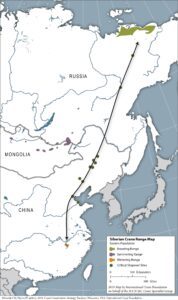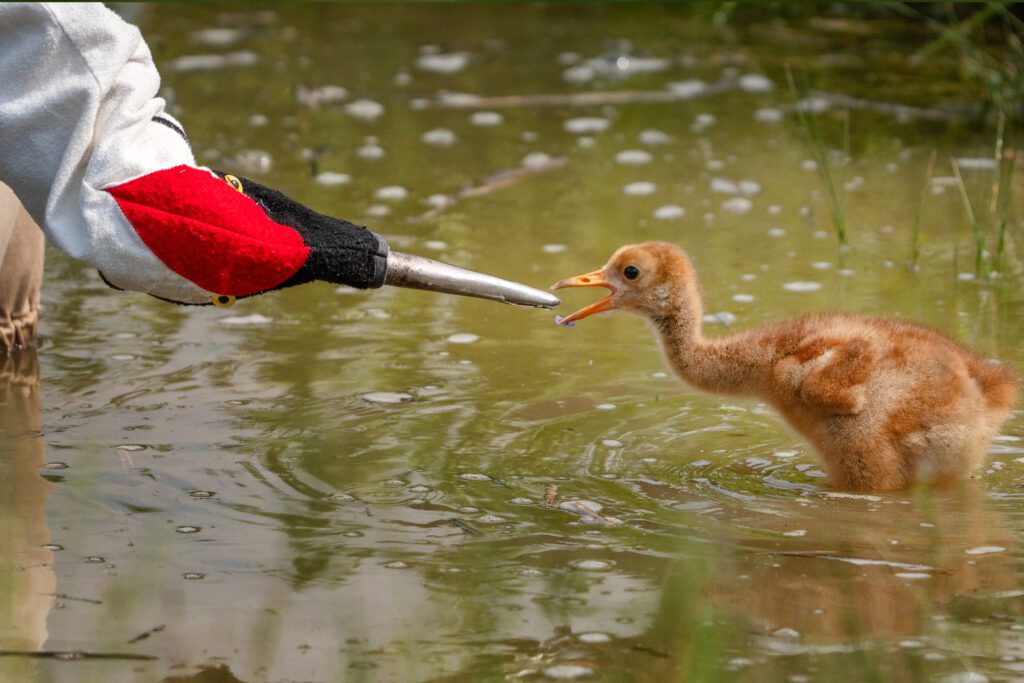Siberian Crane

SPECIES: Leucogeranus leucogeranus
HEIGHT: 140 cm, 5 ft
WEIGHT: 6 kg, 13 lbs
POPULATION: >5,500
TREND: Eastern population stable to increasing, Western/Central population nearly extinct.
STATUS: IUCN: CR; Cites Appendix I; ESA: E; CMS I, II
Photo by Innokentyi Fyodorov
Story of Xiaofei – Siberian Crane
IDENTIFICATION
Adults – red skin on forehead, face and sides of the head, white plumage with black wingtips, reddish pink legs; juvenile – plumage mix of white and cinnamon-brown feathers, tan head.
RANGE
This Critically Endangered species is now only found in one main population in East Asia, with a few birds remaining in the historic Western/Central population. The Eastern population breeds in northeastern Siberia and winters at Poyang Lake in the Lower Yangtze River Basin in China. In the Western/Central population, a single crane continues to winter along the south coast of the Caspian Sea in Iran (click here to learn more about “Omid”). This population bred just south of the Ob River in Russia.
Click to view the range map for the historic Western/Central population

DIET
Cranberries, small mammals, fish, insects, roots and tubers.
CALL
Listen to Siberian Crane calls:
Contact Call | A soft, purring call expressing reassurance and location.
Unison Call | A duet performed by a pair, to strengthen their bond and protect their territory.
THREATS
Habitat loss, especially due to changing hydrology caused by water diversions and conversion of wetlands, illegal take including hunting, trapping and poisoning, pollution and environmental contamination.
OUR PLAN
Our work builds on the strong cultural ties to cranes in East Asia, to engage local communities and policy makers in the conservation of protected areas and their surrounding landscapes, including:
- Ensure healthy populations of Siberian Crane populations in the Amur-Heilong Basin of Russia and China. We are:
- Supporting the development and implementation of water management plans that sustain crane habitats and preserve wetlands for wildlife, flood control, enhancement of water quality, fisheries and other harvests important to people at Zhalong, Momoge, Xianghai, Tumuji, Muraviovka and other key crane wetlands.
- Developing pilot projects in China and Russia that demonstrate community involvement with wetland conservation.
- Promoting cooperative research efforts between crane conservationists in Mongolia and the Amur-Heilong basin of Russia and China.
- Conducting environmental education activities among communities and stakeholders affecting critical crane habitat to increase local and national pride and commitment to conservation action.
Supporting increasing winter populations of Siberian Cranes and maintaining the extraordinary diversity of other waterbird species in Poyang and nearby lakes in southeastern China. We are:
- Determining the effects of different water management scenarios on cranes and their aquatic plant food base.
- Promoting ecosystem approaches to management, including strategies to manage degradation caused by water infrastructure and economic development within its basin.
- Collaborating with Chinese agencies, researchers and local communities to demonstrate how fisheries management and crane protection go together.
Supporting efforts by management agencies and partners to identify and restore alternative wintering sites for cranes in southern China.
Learn more about Siberian Cranes:


